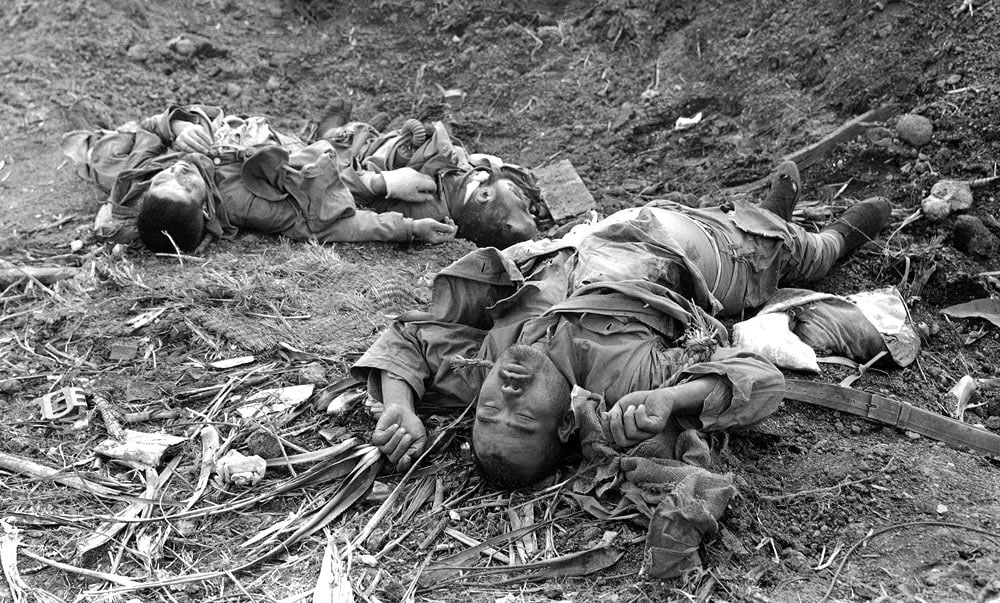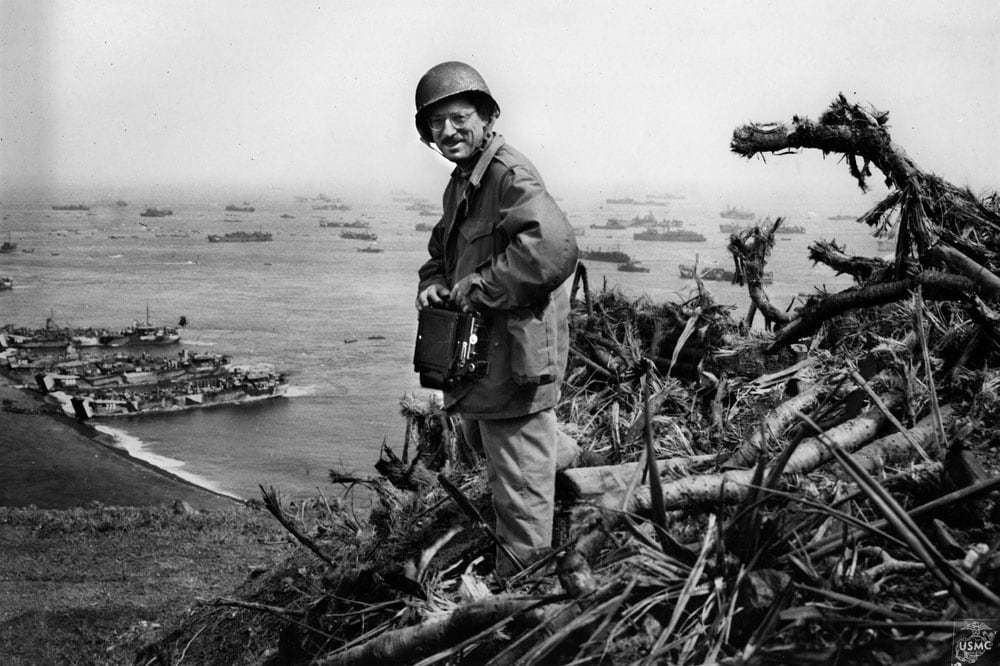
Joe Rosenthal's photo of U.S. Marines raising the flag over Mt. Surabachi on Iwo Jima, Feb. 23, 1945 (Rosenthal/AP)

Marines hit the beach under heavy fire on Iwo Jima. Joe Rosenthal made several of these landings and lived to tell about it. (Rosenthal/AP)

U.S. Corpsmen carry a wounded Marine on a stretcher to an evacuation boat on the beach at Iwo Jima while other Marines huddle in a foxhole during invasion of the Japanese-held island of Iwo Jima (Rosenthal/AP)

Joe takes a photos of the Marines with the raised flag. Because of his diminutive stature, Joe had to stand on sands backs to get the shot! (AP)

U.S. Marines after raising the flag on Iwo Jima. At the time Joe Rosenthal thought this was his best shot before he realized he had captured the iconic raising of the flag. His comments to a reporter about "posing the picture" were misinterpreted to mean this one, not the raising itself. He did not influence the actual flag raising itself, that would have happened whether he was there or not. (Rosenthal/AP)
Today is the 70th anniversary of “The Shot.”
We all know that picture, the one in which, with the click of a shutter, Joe Rosenthal composed the Gettysburg Address of photography. His magnificent moment of U.S. Marines and a Navy corpsman raising the flag on Iwo Jima stands above all others to hang forever in our hearts.
But many other pictures Joe took during the fighting in Europe and through five Pacific campaigns will hold up over time as well.
Like the men he covered, Joe put his life on the line. He said that during his first landing on Iwo Jima the enemy fire was so intense that “not getting hit was like running through rain and not getting wet.”
Joe kept sprinting back to the action, to the danger, even though as a civilian combat cameraman he didn’t have to. It’s hard to comprehend that someone who had hit beaches under fire and witnessed its toll would return to that hell time after time. But, like most men of his era, Joe believed that heroism was no big deal, merely business as usual–and he knew his business. When he could he got names to go with faces, because that sold papers.
Joe Rosenthal’s combat photos consistently show a master at work. He may have had to lug around a 4 x 5 Speed Graphic (and working with one sheet of film at a time meant no “safety” shots), but he got it done. His photographs show the action, the quiet moments, the detritus of death—the disparate elements that comprise the tableau of war.
On Peleliu Joe saw Marines passing comrades covered by impromptu shrouds. Each looks down at the stretchers, as if wondering whether he knew either man. The image seems to illustrate an acceptance that this is how things were, and how the next day they could be lying there.
Joe Rosenthal taught me that some of the best photos happen not while battles rage but at their periphery—advice that stayed with me to great effect as I was photographing the Vietnam War. One of Joe’s strongest images, of a Marine chaplain and congregants at Mass, illuminates the humanity and spirituality of combat-weary men.
A photo he took on a troop transport of men boxing is a classic of a different sort: soldiers crowd around to watch compatriots beat each other up—a metaphor for the battles they’re all heading toward.
Joe had a career after the war, and took plenty of superb photographs. But overshadowing everything he did is that iconic frame freezing forever the gallantry and bravery of a few good men on a hill oh so far away. Their faces are obscured; the focal point is the act, not the personalities—these days a rare phenomenon.
This image will ring through the ages alongside the work of Mozart and Rembrandt and Hemingway. Joe captured the heart and soul of what it means to be a Marine in a picture embodying the essence of Americans. His photo is the symbol of freedom, and the man who took it, a son of immigrants, represents us all.
Joe was a modest guy. Until his death on August 20, 2006, the most prized possession in his spare San Francisco apartment was not, as you might imagine, a print of his greatest photograph. Instead, on the wall above his favorite chair hung a certificate:
“The Commandant of the Marine Corps
Takes pleasure in presenting the title
‘Honorary Marine’
To Joe Rosenthal
‘For unyielding devotion to Country and Corps’
12 April 1996
General, US Marine Corps
Commandant of the Marine Corps”
Joe Rosenthal. Honorary Marine. Great photographer. We who knew him will remember that modest, wonderful and beautiful friend. He will never be forgotten.
(This from a piece I wrote for WWII Magazine about Joe in 2012)








